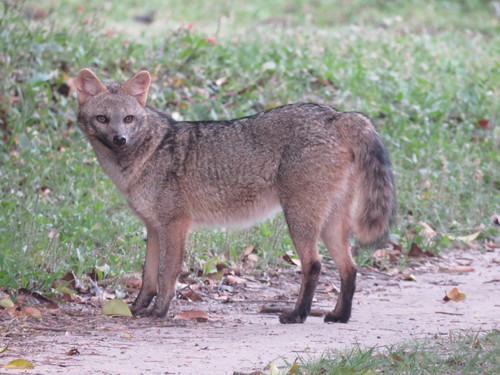
Crab-eating Fox
The crab-eating fox, Cerdocyon thous, thrives in South America's landscapes. With its distinctive grey coat and bushy tail, it navigates nights foraging for fruits and small prey, contributing to seed dispersal and ecosystem balance.
11.5 years
Lifespan
4.54 - 8.16 kg
Weight
Length: 57 - 77 cm
Size
Brown, Grey, Grey-Brown
Color
9 months
Age of Sexual Maturity
90 days
Age of Weaning
Medium
Aggression
Least Concern
Conservation Status
Stable
Population Trend
Characteristics
Cerdocyon thous, also known as the crab-eating fox, inhabits South America's diverse ecosystems, from savannas to forests. This adaptable omnivore is known for its greyish coat, bushy tail, and nocturnal habits. It feeds on a varied diet, including fruits, small mammals, and insects, and plays a crucial role in seed dispersal.
Distribution Range of the Crab-eating Fox
Cerdocyon thous, commonly known as the Crab-eating Fox or Savanna Fox, is native to South America. Its geographical distribution includes countries such as Brazil, Argentina, Uruguay, Paraguay, Bolivia, Peru, Colombia, Venezuela, Guyana, Suriname, and French Guiana. The species is widely found in the tropical and subtropical regions of the continent.
Crab-eating Fox's Habitat
Environmental Conditions
Cerdocyon thous typically inhabits a variety of environments, including savannas, forests, shrublands, and grasslands. It is commonly found in open and semi-open areas with a preference for regions that provide both cover and open spaces for foraging. The species can adapt to different altitudes, from sea level to montane regions, and is often found in areas with moderate rainfall and warm temperatures.
Ecological Niche
As an omnivorous species, the Crab-eating Fox has a versatile diet that includes fruits, insects, small vertebrates, and carrion. This dietary flexibility allows it to thrive in diverse habitats. It plays a role in seed dispersal due to its fruit consumption and contributes to controlling insect and small vertebrate populations. The species is nocturnal and crepuscular, often active during the cooler parts of the day and night.
Copyright @ Nature Style Limited. All Rights Reserved.
 English
English